Small Business Financial Statements Analysis
VerifiedAdded on 2020/06/03
|14
|2025
|203
AI Summary
This assignment presents the financial information of a small business, outlining its income statement, expenses, net profit, and balance sheet details. Students are tasked with analyzing these statements to understand the financial health and performance of the business.
Contribute Materials
Your contribution can guide someone’s learning journey. Share your
documents today.
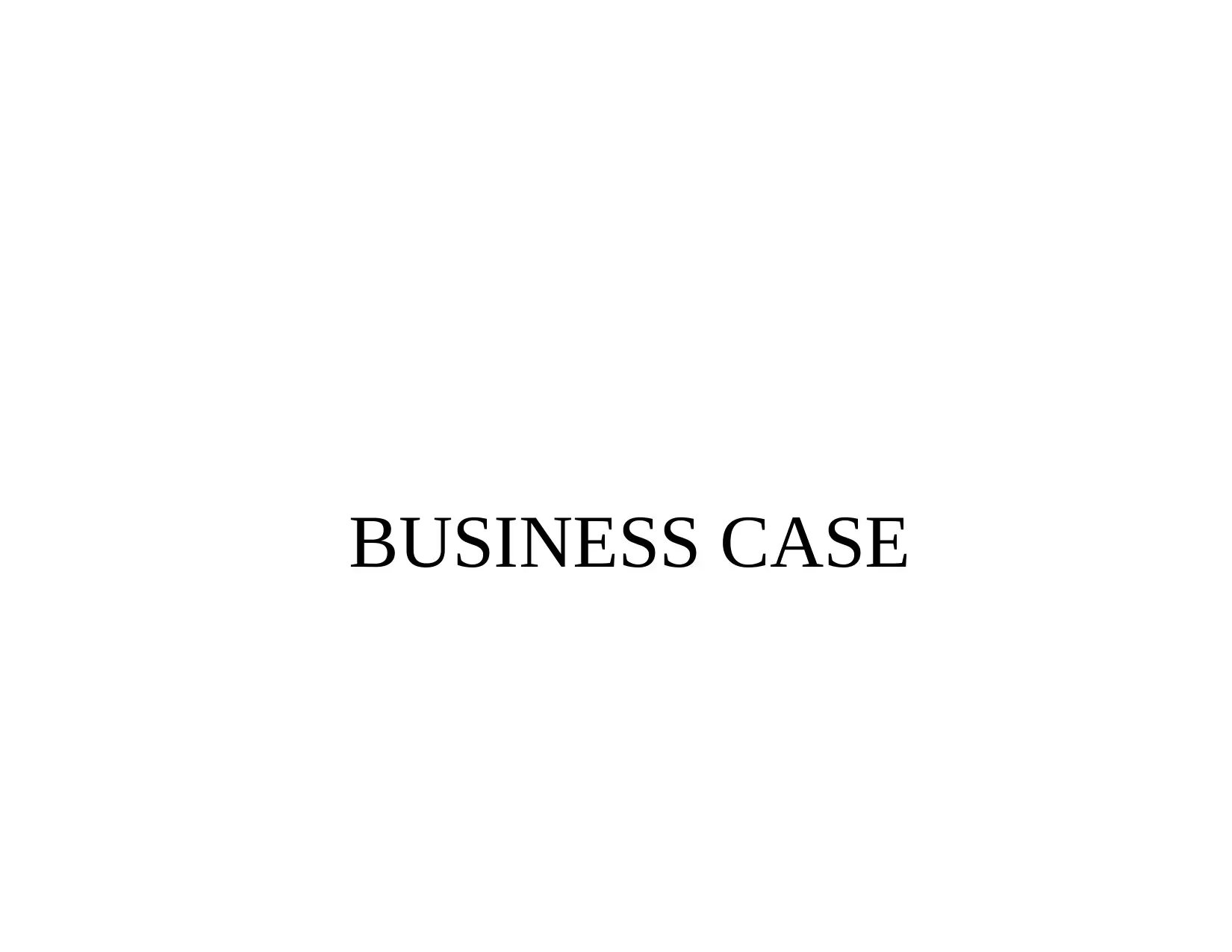
BUSINESS CASE
Secure Best Marks with AI Grader
Need help grading? Try our AI Grader for instant feedback on your assignments.
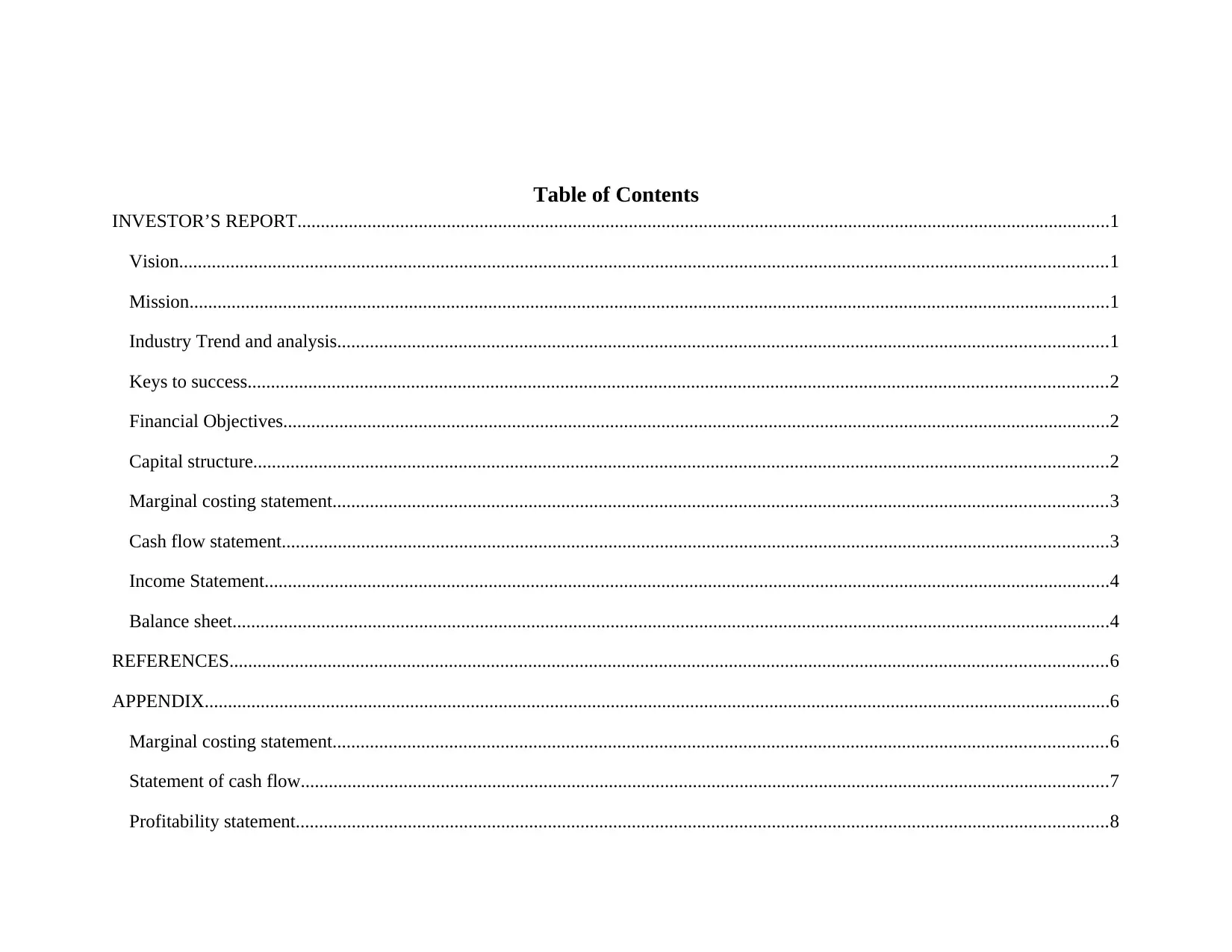
Table of Contents
INVESTOR’S REPORT..............................................................................................................................................................................1
Vision.......................................................................................................................................................................................................1
Mission.....................................................................................................................................................................................................1
Industry Trend and analysis.....................................................................................................................................................................1
Keys to success........................................................................................................................................................................................2
Financial Objectives.................................................................................................................................................................................2
Capital structure.......................................................................................................................................................................................2
Marginal costing statement......................................................................................................................................................................3
Cash flow statement.................................................................................................................................................................................3
Income Statement.....................................................................................................................................................................................4
Balance sheet............................................................................................................................................................................................4
REFERENCES............................................................................................................................................................................................6
APPENDIX..................................................................................................................................................................................................6
Marginal costing statement......................................................................................................................................................................6
Statement of cash flow.............................................................................................................................................................................7
Profitability statement..............................................................................................................................................................................8
INVESTOR’S REPORT..............................................................................................................................................................................1
Vision.......................................................................................................................................................................................................1
Mission.....................................................................................................................................................................................................1
Industry Trend and analysis.....................................................................................................................................................................1
Keys to success........................................................................................................................................................................................2
Financial Objectives.................................................................................................................................................................................2
Capital structure.......................................................................................................................................................................................2
Marginal costing statement......................................................................................................................................................................3
Cash flow statement.................................................................................................................................................................................3
Income Statement.....................................................................................................................................................................................4
Balance sheet............................................................................................................................................................................................4
REFERENCES............................................................................................................................................................................................6
APPENDIX..................................................................................................................................................................................................6
Marginal costing statement......................................................................................................................................................................6
Statement of cash flow.............................................................................................................................................................................7
Profitability statement..............................................................................................................................................................................8
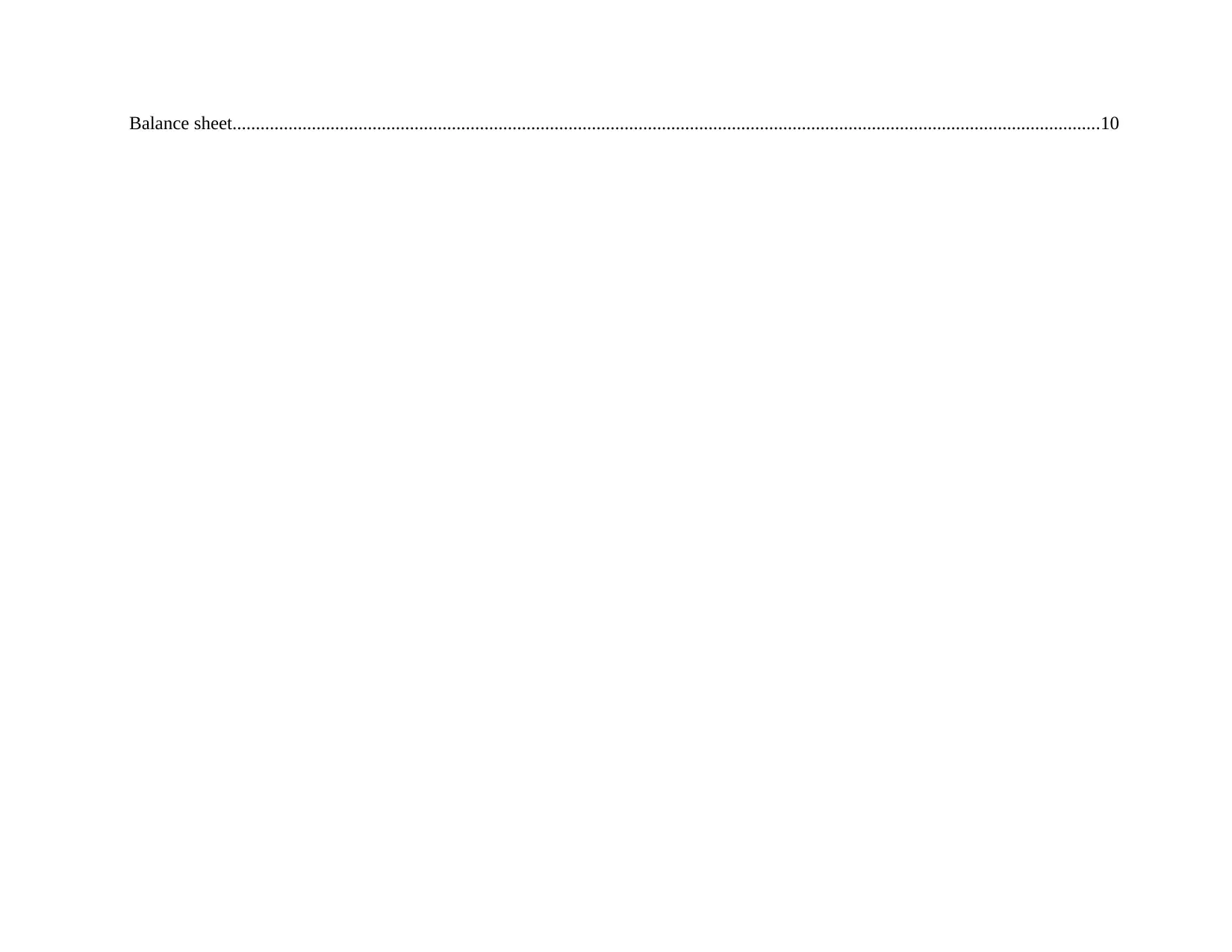
Balance sheet..........................................................................................................................................................................................10
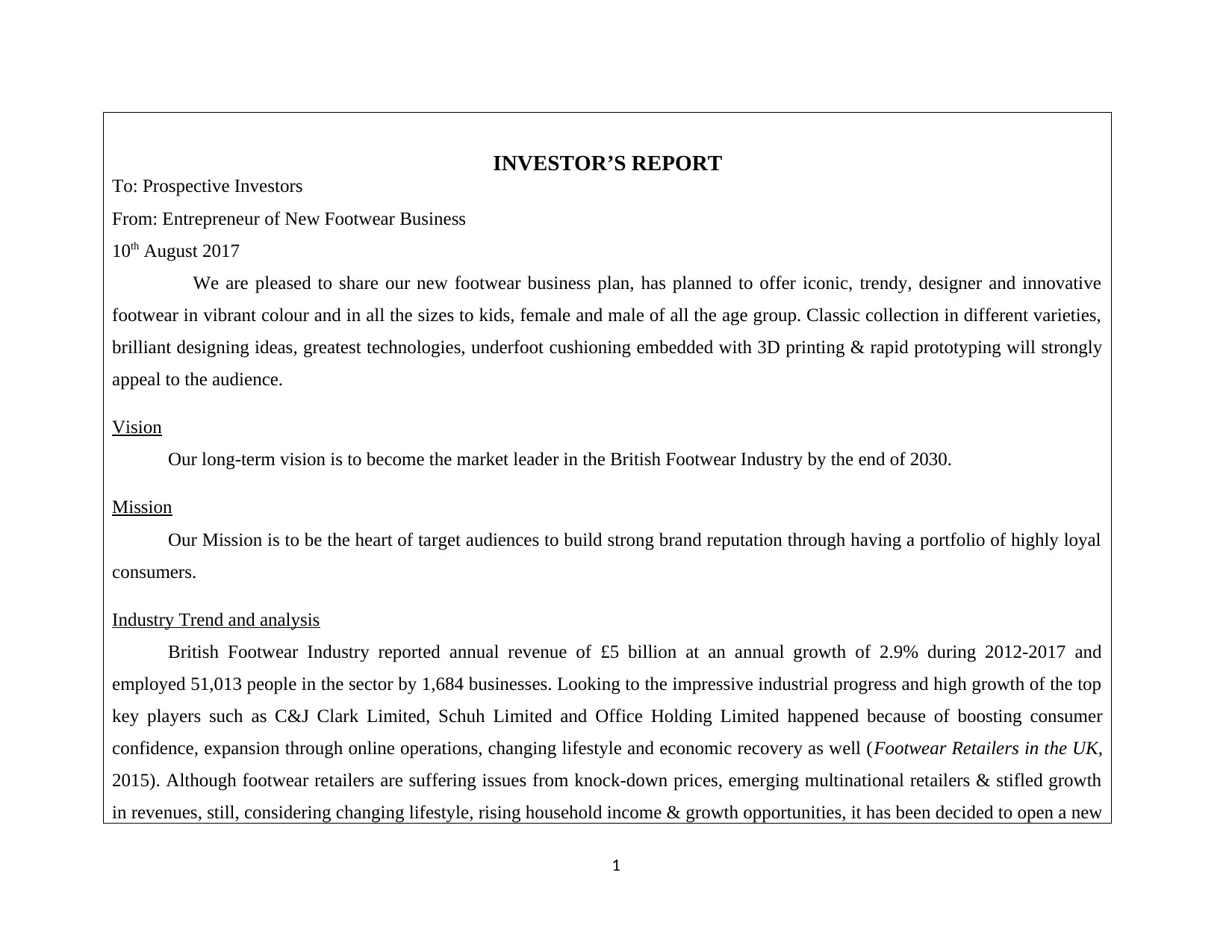
INVESTOR’S REPORT
To: Prospective Investors
From: Entrepreneur of New Footwear Business
10th August 2017
We are pleased to share our new footwear business plan, has planned to offer iconic, trendy, designer and innovative
footwear in vibrant colour and in all the sizes to kids, female and male of all the age group. Classic collection in different varieties,
brilliant designing ideas, greatest technologies, underfoot cushioning embedded with 3D printing & rapid prototyping will strongly
appeal to the audience.
Vision
Our long-term vision is to become the market leader in the British Footwear Industry by the end of 2030.
Mission
Our Mission is to be the heart of target audiences to build strong brand reputation through having a portfolio of highly loyal
consumers.
Industry Trend and analysis
British Footwear Industry reported annual revenue of £5 billion at an annual growth of 2.9% during 2012-2017 and
employed 51,013 people in the sector by 1,684 businesses. Looking to the impressive industrial progress and high growth of the top
key players such as C&J Clark Limited, Schuh Limited and Office Holding Limited happened because of boosting consumer
confidence, expansion through online operations, changing lifestyle and economic recovery as well (Footwear Retailers in the UK,
2015). Although footwear retailers are suffering issues from knock-down prices, emerging multinational retailers & stifled growth
in revenues, still, considering changing lifestyle, rising household income & growth opportunities, it has been decided to open a new
1
To: Prospective Investors
From: Entrepreneur of New Footwear Business
10th August 2017
We are pleased to share our new footwear business plan, has planned to offer iconic, trendy, designer and innovative
footwear in vibrant colour and in all the sizes to kids, female and male of all the age group. Classic collection in different varieties,
brilliant designing ideas, greatest technologies, underfoot cushioning embedded with 3D printing & rapid prototyping will strongly
appeal to the audience.
Vision
Our long-term vision is to become the market leader in the British Footwear Industry by the end of 2030.
Mission
Our Mission is to be the heart of target audiences to build strong brand reputation through having a portfolio of highly loyal
consumers.
Industry Trend and analysis
British Footwear Industry reported annual revenue of £5 billion at an annual growth of 2.9% during 2012-2017 and
employed 51,013 people in the sector by 1,684 businesses. Looking to the impressive industrial progress and high growth of the top
key players such as C&J Clark Limited, Schuh Limited and Office Holding Limited happened because of boosting consumer
confidence, expansion through online operations, changing lifestyle and economic recovery as well (Footwear Retailers in the UK,
2015). Although footwear retailers are suffering issues from knock-down prices, emerging multinational retailers & stifled growth
in revenues, still, considering changing lifestyle, rising household income & growth opportunities, it has been decided to open a new
1
Secure Best Marks with AI Grader
Need help grading? Try our AI Grader for instant feedback on your assignments.
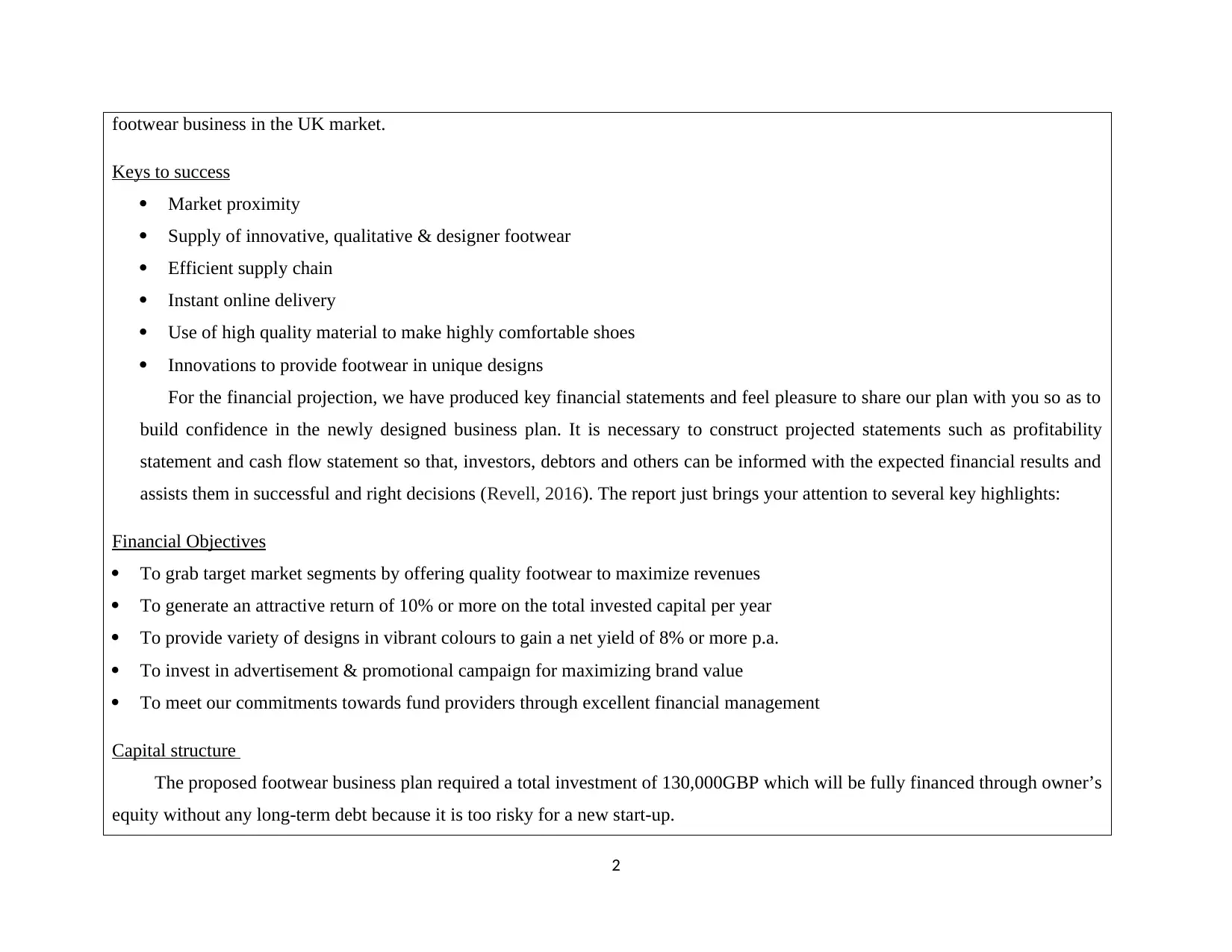
footwear business in the UK market.
Keys to success
Market proximity
Supply of innovative, qualitative & designer footwear
Efficient supply chain
Instant online delivery
Use of high quality material to make highly comfortable shoes
Innovations to provide footwear in unique designs
For the financial projection, we have produced key financial statements and feel pleasure to share our plan with you so as to
build confidence in the newly designed business plan. It is necessary to construct projected statements such as profitability
statement and cash flow statement so that, investors, debtors and others can be informed with the expected financial results and
assists them in successful and right decisions (Revell, 2016). The report just brings your attention to several key highlights:
Financial Objectives
To grab target market segments by offering quality footwear to maximize revenues
To generate an attractive return of 10% or more on the total invested capital per year
To provide variety of designs in vibrant colours to gain a net yield of 8% or more p.a.
To invest in advertisement & promotional campaign for maximizing brand value
To meet our commitments towards fund providers through excellent financial management
Capital structure
The proposed footwear business plan required a total investment of 130,000GBP which will be fully financed through owner’s
equity without any long-term debt because it is too risky for a new start-up.
2
Keys to success
Market proximity
Supply of innovative, qualitative & designer footwear
Efficient supply chain
Instant online delivery
Use of high quality material to make highly comfortable shoes
Innovations to provide footwear in unique designs
For the financial projection, we have produced key financial statements and feel pleasure to share our plan with you so as to
build confidence in the newly designed business plan. It is necessary to construct projected statements such as profitability
statement and cash flow statement so that, investors, debtors and others can be informed with the expected financial results and
assists them in successful and right decisions (Revell, 2016). The report just brings your attention to several key highlights:
Financial Objectives
To grab target market segments by offering quality footwear to maximize revenues
To generate an attractive return of 10% or more on the total invested capital per year
To provide variety of designs in vibrant colours to gain a net yield of 8% or more p.a.
To invest in advertisement & promotional campaign for maximizing brand value
To meet our commitments towards fund providers through excellent financial management
Capital structure
The proposed footwear business plan required a total investment of 130,000GBP which will be fully financed through owner’s
equity without any long-term debt because it is too risky for a new start-up.
2
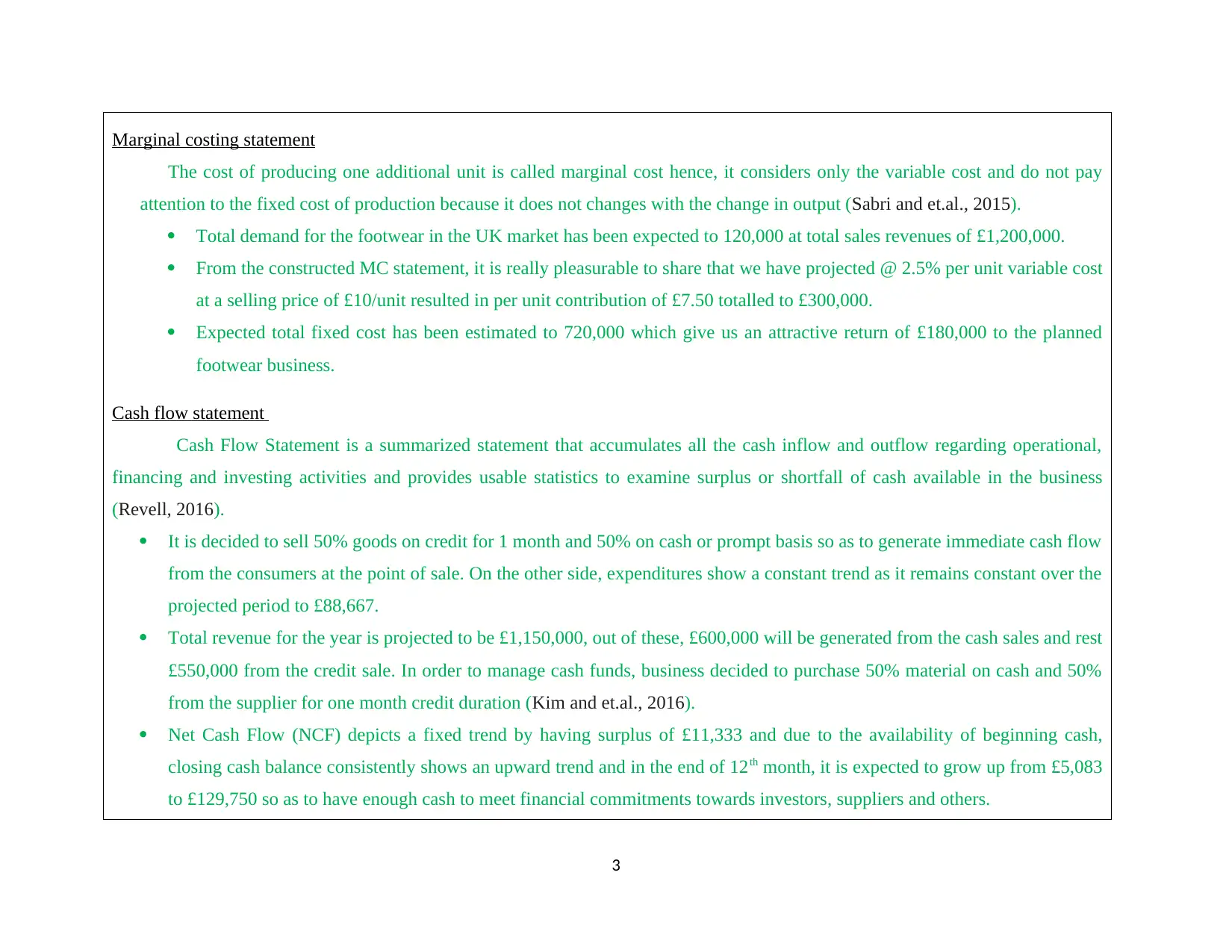
Marginal costing statement
The cost of producing one additional unit is called marginal cost hence, it considers only the variable cost and do not pay
attention to the fixed cost of production because it does not changes with the change in output (Sabri and et.al., 2015).
Total demand for the footwear in the UK market has been expected to 120,000 at total sales revenues of £1,200,000.
From the constructed MC statement, it is really pleasurable to share that we have projected @ 2.5% per unit variable cost
at a selling price of £10/unit resulted in per unit contribution of £7.50 totalled to £300,000.
Expected total fixed cost has been estimated to 720,000 which give us an attractive return of £180,000 to the planned
footwear business.
Cash flow statement
Cash Flow Statement is a summarized statement that accumulates all the cash inflow and outflow regarding operational,
financing and investing activities and provides usable statistics to examine surplus or shortfall of cash available in the business
(Revell, 2016).
It is decided to sell 50% goods on credit for 1 month and 50% on cash or prompt basis so as to generate immediate cash flow
from the consumers at the point of sale. On the other side, expenditures show a constant trend as it remains constant over the
projected period to £88,667.
Total revenue for the year is projected to be £1,150,000, out of these, £600,000 will be generated from the cash sales and rest
£550,000 from the credit sale. In order to manage cash funds, business decided to purchase 50% material on cash and 50%
from the supplier for one month credit duration (Kim and et.al., 2016).
Net Cash Flow (NCF) depicts a fixed trend by having surplus of £11,333 and due to the availability of beginning cash,
closing cash balance consistently shows an upward trend and in the end of 12th month, it is expected to grow up from £5,083
to £129,750 so as to have enough cash to meet financial commitments towards investors, suppliers and others.
3
The cost of producing one additional unit is called marginal cost hence, it considers only the variable cost and do not pay
attention to the fixed cost of production because it does not changes with the change in output (Sabri and et.al., 2015).
Total demand for the footwear in the UK market has been expected to 120,000 at total sales revenues of £1,200,000.
From the constructed MC statement, it is really pleasurable to share that we have projected @ 2.5% per unit variable cost
at a selling price of £10/unit resulted in per unit contribution of £7.50 totalled to £300,000.
Expected total fixed cost has been estimated to 720,000 which give us an attractive return of £180,000 to the planned
footwear business.
Cash flow statement
Cash Flow Statement is a summarized statement that accumulates all the cash inflow and outflow regarding operational,
financing and investing activities and provides usable statistics to examine surplus or shortfall of cash available in the business
(Revell, 2016).
It is decided to sell 50% goods on credit for 1 month and 50% on cash or prompt basis so as to generate immediate cash flow
from the consumers at the point of sale. On the other side, expenditures show a constant trend as it remains constant over the
projected period to £88,667.
Total revenue for the year is projected to be £1,150,000, out of these, £600,000 will be generated from the cash sales and rest
£550,000 from the credit sale. In order to manage cash funds, business decided to purchase 50% material on cash and 50%
from the supplier for one month credit duration (Kim and et.al., 2016).
Net Cash Flow (NCF) depicts a fixed trend by having surplus of £11,333 and due to the availability of beginning cash,
closing cash balance consistently shows an upward trend and in the end of 12th month, it is expected to grow up from £5,083
to £129,750 so as to have enough cash to meet financial commitments towards investors, suppliers and others.
3
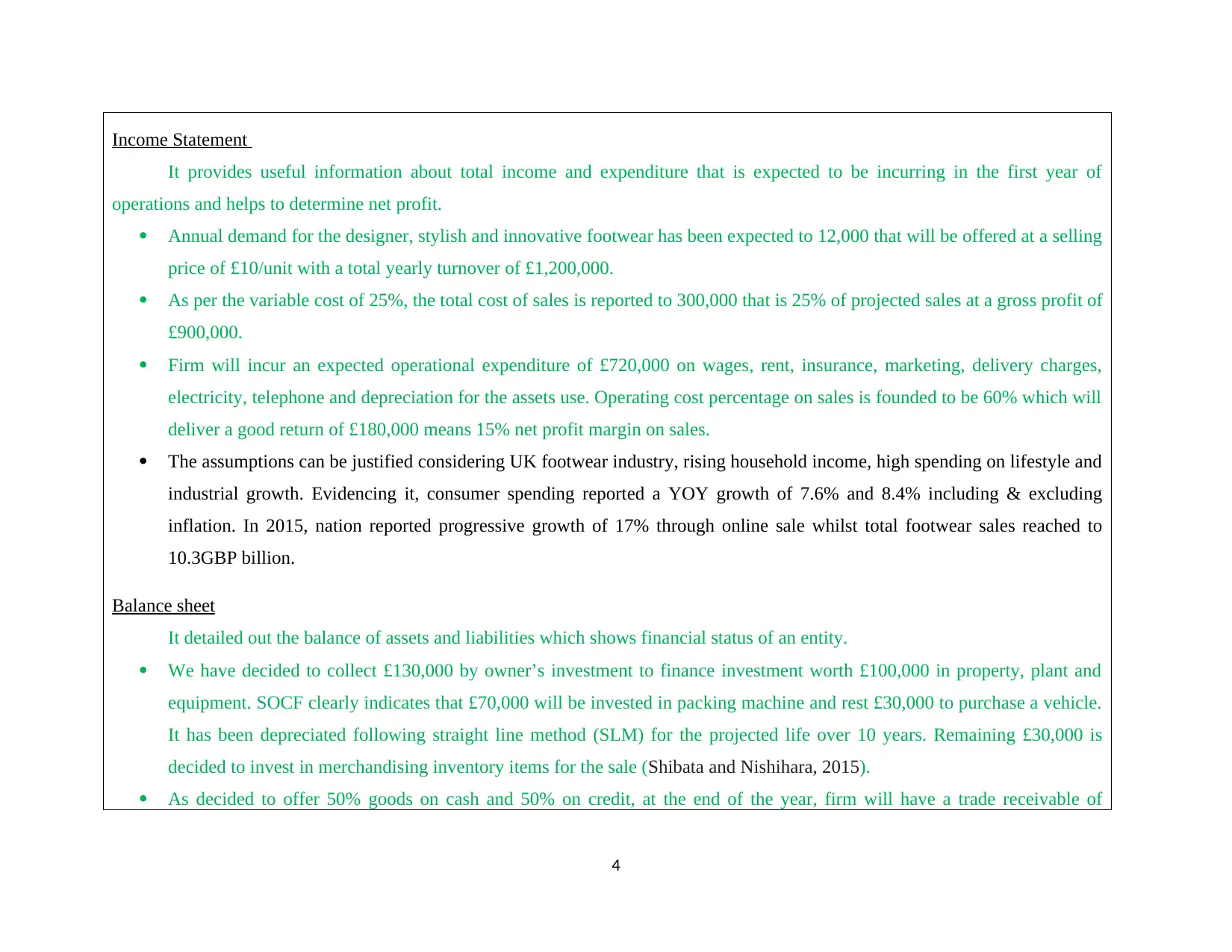
Income Statement
It provides useful information about total income and expenditure that is expected to be incurring in the first year of
operations and helps to determine net profit.
Annual demand for the designer, stylish and innovative footwear has been expected to 12,000 that will be offered at a selling
price of £10/unit with a total yearly turnover of £1,200,000.
As per the variable cost of 25%, the total cost of sales is reported to 300,000 that is 25% of projected sales at a gross profit of
£900,000.
Firm will incur an expected operational expenditure of £720,000 on wages, rent, insurance, marketing, delivery charges,
electricity, telephone and depreciation for the assets use. Operating cost percentage on sales is founded to be 60% which will
deliver a good return of £180,000 means 15% net profit margin on sales.
The assumptions can be justified considering UK footwear industry, rising household income, high spending on lifestyle and
industrial growth. Evidencing it, consumer spending reported a YOY growth of 7.6% and 8.4% including & excluding
inflation. In 2015, nation reported progressive growth of 17% through online sale whilst total footwear sales reached to
10.3GBP billion.
Balance sheet
It detailed out the balance of assets and liabilities which shows financial status of an entity.
We have decided to collect £130,000 by owner’s investment to finance investment worth £100,000 in property, plant and
equipment. SOCF clearly indicates that £70,000 will be invested in packing machine and rest £30,000 to purchase a vehicle.
It has been depreciated following straight line method (SLM) for the projected life over 10 years. Remaining £30,000 is
decided to invest in merchandising inventory items for the sale (Shibata and Nishihara, 2015).
As decided to offer 50% goods on cash and 50% on credit, at the end of the year, firm will have a trade receivable of
4
It provides useful information about total income and expenditure that is expected to be incurring in the first year of
operations and helps to determine net profit.
Annual demand for the designer, stylish and innovative footwear has been expected to 12,000 that will be offered at a selling
price of £10/unit with a total yearly turnover of £1,200,000.
As per the variable cost of 25%, the total cost of sales is reported to 300,000 that is 25% of projected sales at a gross profit of
£900,000.
Firm will incur an expected operational expenditure of £720,000 on wages, rent, insurance, marketing, delivery charges,
electricity, telephone and depreciation for the assets use. Operating cost percentage on sales is founded to be 60% which will
deliver a good return of £180,000 means 15% net profit margin on sales.
The assumptions can be justified considering UK footwear industry, rising household income, high spending on lifestyle and
industrial growth. Evidencing it, consumer spending reported a YOY growth of 7.6% and 8.4% including & excluding
inflation. In 2015, nation reported progressive growth of 17% through online sale whilst total footwear sales reached to
10.3GBP billion.
Balance sheet
It detailed out the balance of assets and liabilities which shows financial status of an entity.
We have decided to collect £130,000 by owner’s investment to finance investment worth £100,000 in property, plant and
equipment. SOCF clearly indicates that £70,000 will be invested in packing machine and rest £30,000 to purchase a vehicle.
It has been depreciated following straight line method (SLM) for the projected life over 10 years. Remaining £30,000 is
decided to invest in merchandising inventory items for the sale (Shibata and Nishihara, 2015).
As decided to offer 50% goods on cash and 50% on credit, at the end of the year, firm will have a trade receivable of
4
Paraphrase This Document
Need a fresh take? Get an instant paraphrase of this document with our AI Paraphraser
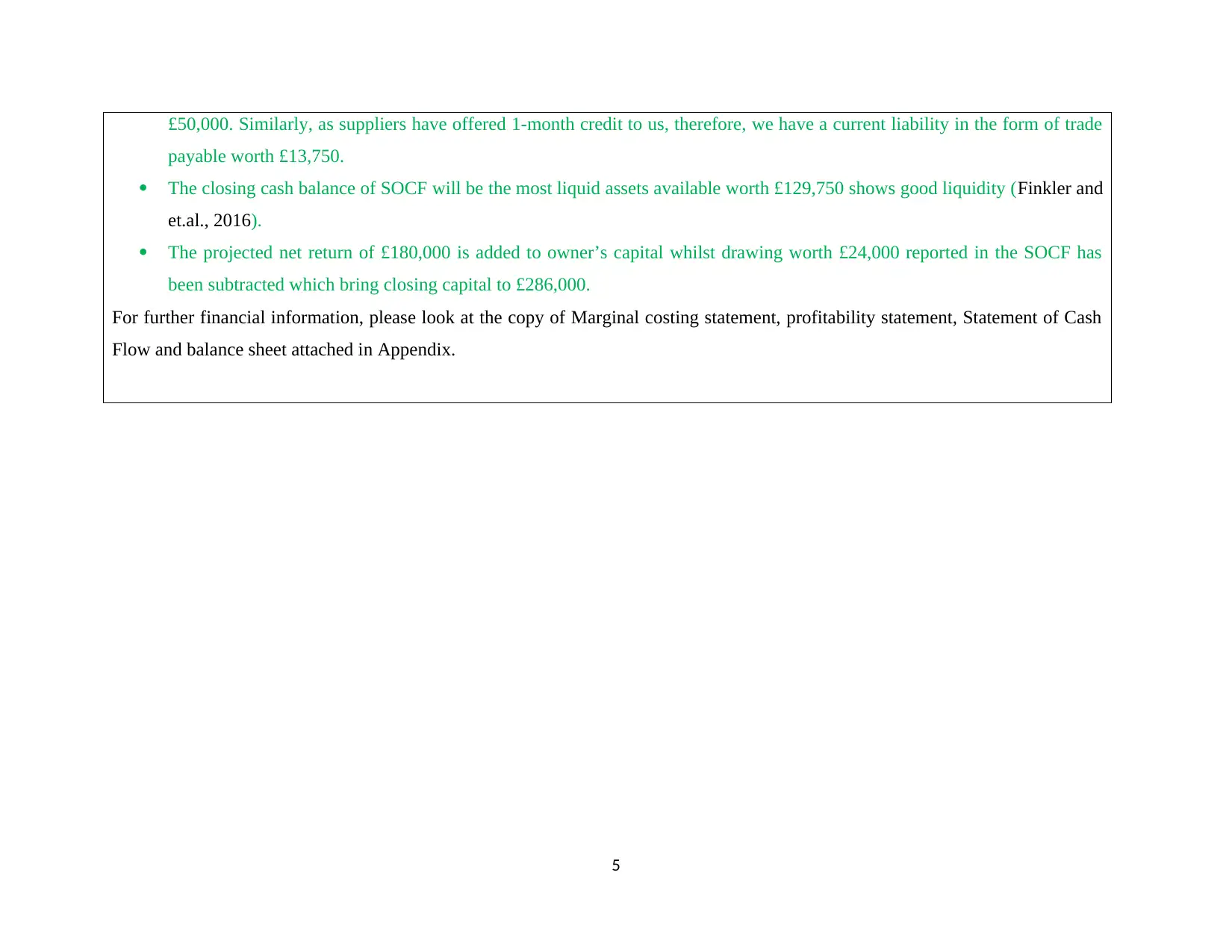
£50,000. Similarly, as suppliers have offered 1-month credit to us, therefore, we have a current liability in the form of trade
payable worth £13,750.
The closing cash balance of SOCF will be the most liquid assets available worth £129,750 shows good liquidity (Finkler and
et.al., 2016).
The projected net return of £180,000 is added to owner’s capital whilst drawing worth £24,000 reported in the SOCF has
been subtracted which bring closing capital to £286,000.
For further financial information, please look at the copy of Marginal costing statement, profitability statement, Statement of Cash
Flow and balance sheet attached in Appendix.
5
payable worth £13,750.
The closing cash balance of SOCF will be the most liquid assets available worth £129,750 shows good liquidity (Finkler and
et.al., 2016).
The projected net return of £180,000 is added to owner’s capital whilst drawing worth £24,000 reported in the SOCF has
been subtracted which bring closing capital to £286,000.
For further financial information, please look at the copy of Marginal costing statement, profitability statement, Statement of Cash
Flow and balance sheet attached in Appendix.
5
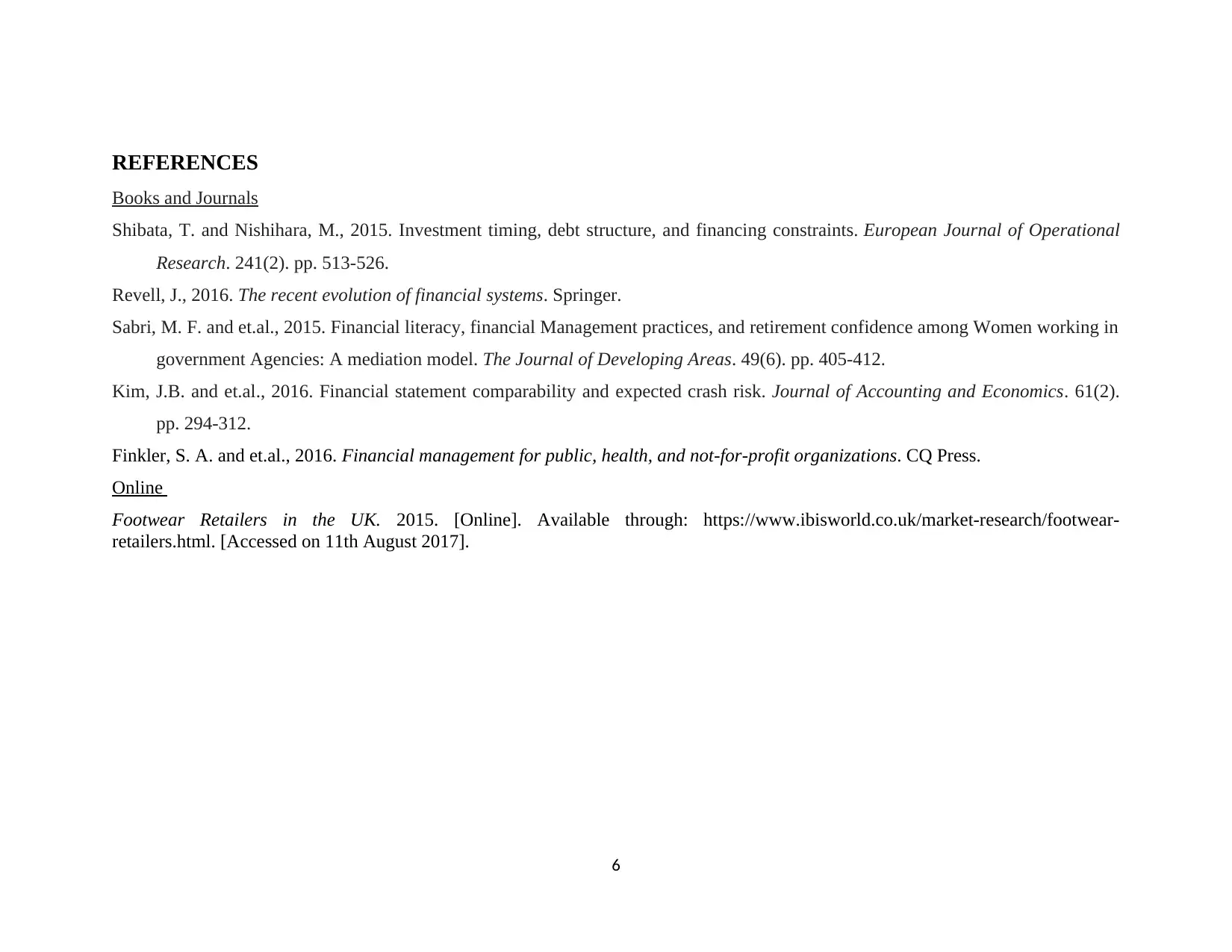
REFERENCES
Books and Journals
Shibata, T. and Nishihara, M., 2015. Investment timing, debt structure, and financing constraints. European Journal of Operational
Research. 241(2). pp. 513-526.
Revell, J., 2016. The recent evolution of financial systems. Springer.
Sabri, M. F. and et.al., 2015. Financial literacy, financial Management practices, and retirement confidence among Women working in
government Agencies: A mediation model. The Journal of Developing Areas. 49(6). pp. 405-412.
Kim, J.B. and et.al., 2016. Financial statement comparability and expected crash risk. Journal of Accounting and Economics. 61(2).
pp. 294-312.
Finkler, S. A. and et.al., 2016. Financial management for public, health, and not-for-profit organizations. CQ Press.
Online
Footwear Retailers in the UK. 2015. [Online]. Available through: https://www.ibisworld.co.uk/market-research/footwear-
retailers.html. [Accessed on 11th August 2017].
6
Books and Journals
Shibata, T. and Nishihara, M., 2015. Investment timing, debt structure, and financing constraints. European Journal of Operational
Research. 241(2). pp. 513-526.
Revell, J., 2016. The recent evolution of financial systems. Springer.
Sabri, M. F. and et.al., 2015. Financial literacy, financial Management practices, and retirement confidence among Women working in
government Agencies: A mediation model. The Journal of Developing Areas. 49(6). pp. 405-412.
Kim, J.B. and et.al., 2016. Financial statement comparability and expected crash risk. Journal of Accounting and Economics. 61(2).
pp. 294-312.
Finkler, S. A. and et.al., 2016. Financial management for public, health, and not-for-profit organizations. CQ Press.
Online
Footwear Retailers in the UK. 2015. [Online]. Available through: https://www.ibisworld.co.uk/market-research/footwear-
retailers.html. [Accessed on 11th August 2017].
6
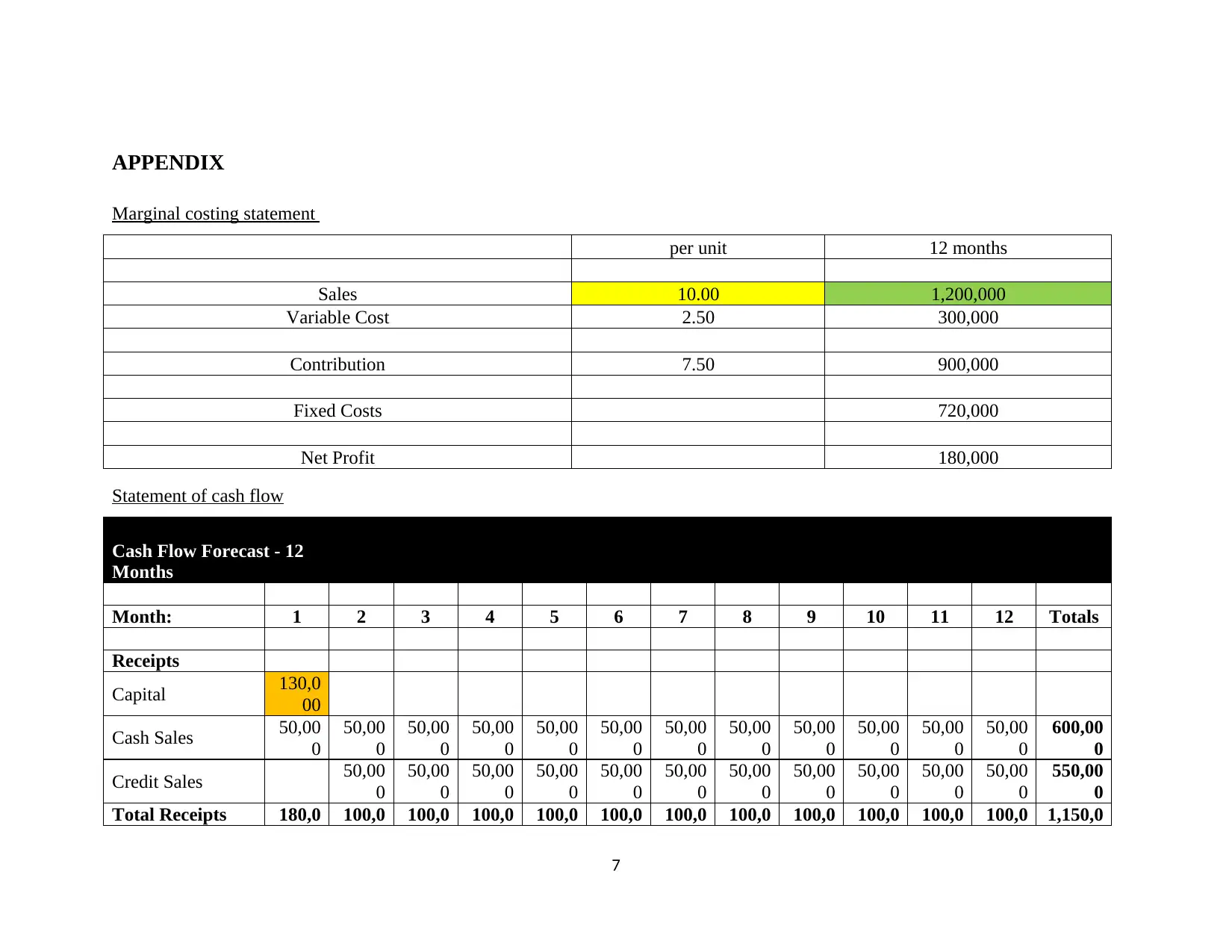
APPENDIX
Marginal costing statement
per unit 12 months
Sales 10.00 1,200,000
Variable Cost 2.50 300,000
Contribution 7.50 900,000
Fixed Costs 720,000
Net Profit 180,000
Statement of cash flow
Cash Flow Forecast - 12
Months
Month: 1 2 3 4 5 6 7 8 9 10 11 12 Totals
Receipts
Capital 130,0
00
Cash Sales 50,00
0
50,00
0
50,00
0
50,00
0
50,00
0
50,00
0
50,00
0
50,00
0
50,00
0
50,00
0
50,00
0
50,00
0
600,00
0
Credit Sales 50,00
0
50,00
0
50,00
0
50,00
0
50,00
0
50,00
0
50,00
0
50,00
0
50,00
0
50,00
0
50,00
0
550,00
0
Total Receipts 180,0 100,0 100,0 100,0 100,0 100,0 100,0 100,0 100,0 100,0 100,0 100,0 1,150,0
7
Marginal costing statement
per unit 12 months
Sales 10.00 1,200,000
Variable Cost 2.50 300,000
Contribution 7.50 900,000
Fixed Costs 720,000
Net Profit 180,000
Statement of cash flow
Cash Flow Forecast - 12
Months
Month: 1 2 3 4 5 6 7 8 9 10 11 12 Totals
Receipts
Capital 130,0
00
Cash Sales 50,00
0
50,00
0
50,00
0
50,00
0
50,00
0
50,00
0
50,00
0
50,00
0
50,00
0
50,00
0
50,00
0
50,00
0
600,00
0
Credit Sales 50,00
0
50,00
0
50,00
0
50,00
0
50,00
0
50,00
0
50,00
0
50,00
0
50,00
0
50,00
0
50,00
0
550,00
0
Total Receipts 180,0 100,0 100,0 100,0 100,0 100,0 100,0 100,0 100,0 100,0 100,0 100,0 1,150,0
7
Secure Best Marks with AI Grader
Need help grading? Try our AI Grader for instant feedback on your assignments.
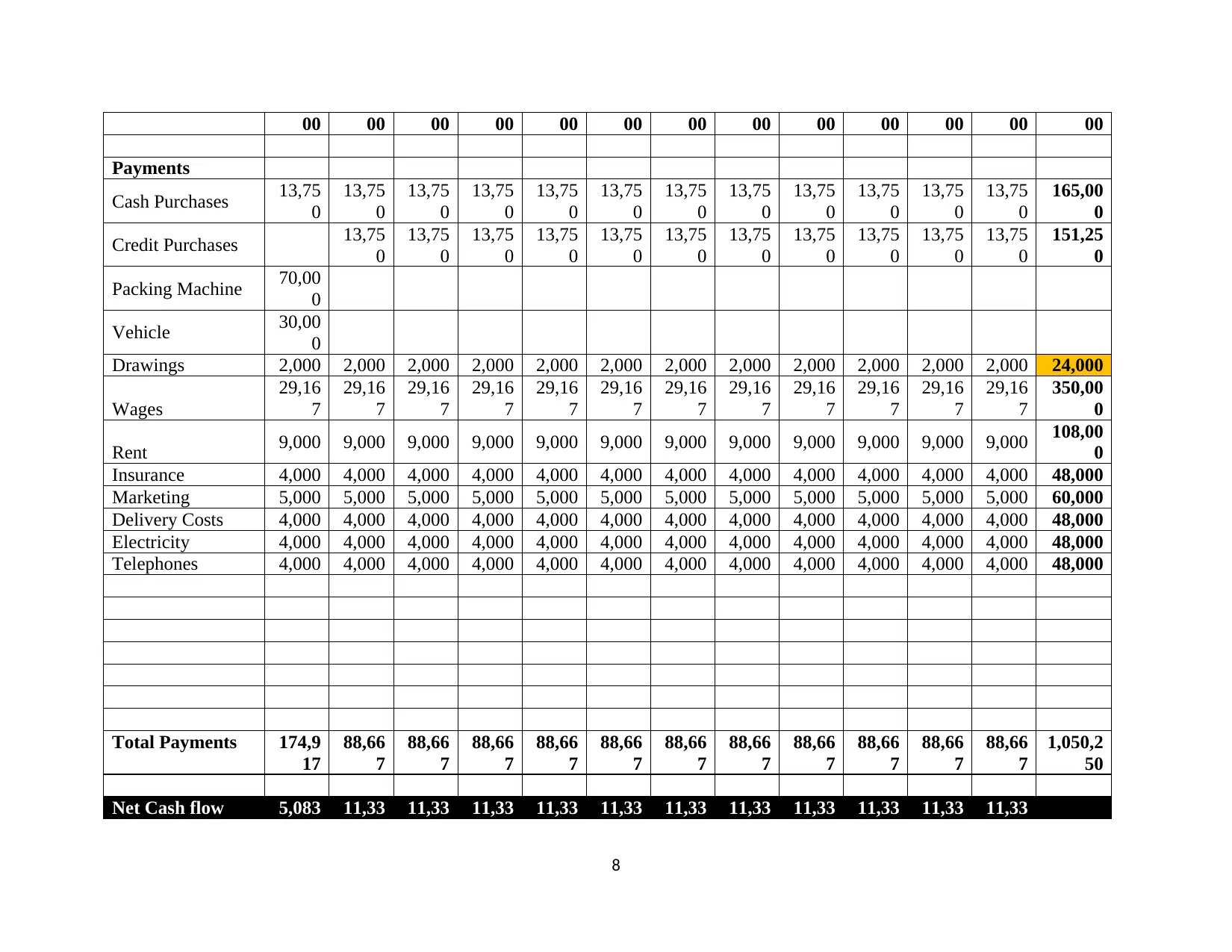
00 00 00 00 00 00 00 00 00 00 00 00 00
Payments
Cash Purchases 13,75
0
13,75
0
13,75
0
13,75
0
13,75
0
13,75
0
13,75
0
13,75
0
13,75
0
13,75
0
13,75
0
13,75
0
165,00
0
Credit Purchases 13,75
0
13,75
0
13,75
0
13,75
0
13,75
0
13,75
0
13,75
0
13,75
0
13,75
0
13,75
0
13,75
0
151,25
0
Packing Machine 70,00
0
Vehicle 30,00
0
Drawings 2,000 2,000 2,000 2,000 2,000 2,000 2,000 2,000 2,000 2,000 2,000 2,000 24,000
Wages
29,16
7
29,16
7
29,16
7
29,16
7
29,16
7
29,16
7
29,16
7
29,16
7
29,16
7
29,16
7
29,16
7
29,16
7
350,00
0
Rent 9,000 9,000 9,000 9,000 9,000 9,000 9,000 9,000 9,000 9,000 9,000 9,000 108,00
0
Insurance 4,000 4,000 4,000 4,000 4,000 4,000 4,000 4,000 4,000 4,000 4,000 4,000 48,000
Marketing 5,000 5,000 5,000 5,000 5,000 5,000 5,000 5,000 5,000 5,000 5,000 5,000 60,000
Delivery Costs 4,000 4,000 4,000 4,000 4,000 4,000 4,000 4,000 4,000 4,000 4,000 4,000 48,000
Electricity 4,000 4,000 4,000 4,000 4,000 4,000 4,000 4,000 4,000 4,000 4,000 4,000 48,000
Telephones 4,000 4,000 4,000 4,000 4,000 4,000 4,000 4,000 4,000 4,000 4,000 4,000 48,000
Total Payments 174,9
17
88,66
7
88,66
7
88,66
7
88,66
7
88,66
7
88,66
7
88,66
7
88,66
7
88,66
7
88,66
7
88,66
7
1,050,2
50
Net Cash flow 5,083 11,33 11,33 11,33 11,33 11,33 11,33 11,33 11,33 11,33 11,33 11,33
8
Payments
Cash Purchases 13,75
0
13,75
0
13,75
0
13,75
0
13,75
0
13,75
0
13,75
0
13,75
0
13,75
0
13,75
0
13,75
0
13,75
0
165,00
0
Credit Purchases 13,75
0
13,75
0
13,75
0
13,75
0
13,75
0
13,75
0
13,75
0
13,75
0
13,75
0
13,75
0
13,75
0
151,25
0
Packing Machine 70,00
0
Vehicle 30,00
0
Drawings 2,000 2,000 2,000 2,000 2,000 2,000 2,000 2,000 2,000 2,000 2,000 2,000 24,000
Wages
29,16
7
29,16
7
29,16
7
29,16
7
29,16
7
29,16
7
29,16
7
29,16
7
29,16
7
29,16
7
29,16
7
29,16
7
350,00
0
Rent 9,000 9,000 9,000 9,000 9,000 9,000 9,000 9,000 9,000 9,000 9,000 9,000 108,00
0
Insurance 4,000 4,000 4,000 4,000 4,000 4,000 4,000 4,000 4,000 4,000 4,000 4,000 48,000
Marketing 5,000 5,000 5,000 5,000 5,000 5,000 5,000 5,000 5,000 5,000 5,000 5,000 60,000
Delivery Costs 4,000 4,000 4,000 4,000 4,000 4,000 4,000 4,000 4,000 4,000 4,000 4,000 48,000
Electricity 4,000 4,000 4,000 4,000 4,000 4,000 4,000 4,000 4,000 4,000 4,000 4,000 48,000
Telephones 4,000 4,000 4,000 4,000 4,000 4,000 4,000 4,000 4,000 4,000 4,000 4,000 48,000
Total Payments 174,9
17
88,66
7
88,66
7
88,66
7
88,66
7
88,66
7
88,66
7
88,66
7
88,66
7
88,66
7
88,66
7
88,66
7
1,050,2
50
Net Cash flow 5,083 11,33 11,33 11,33 11,33 11,33 11,33 11,33 11,33 11,33 11,33 11,33
8
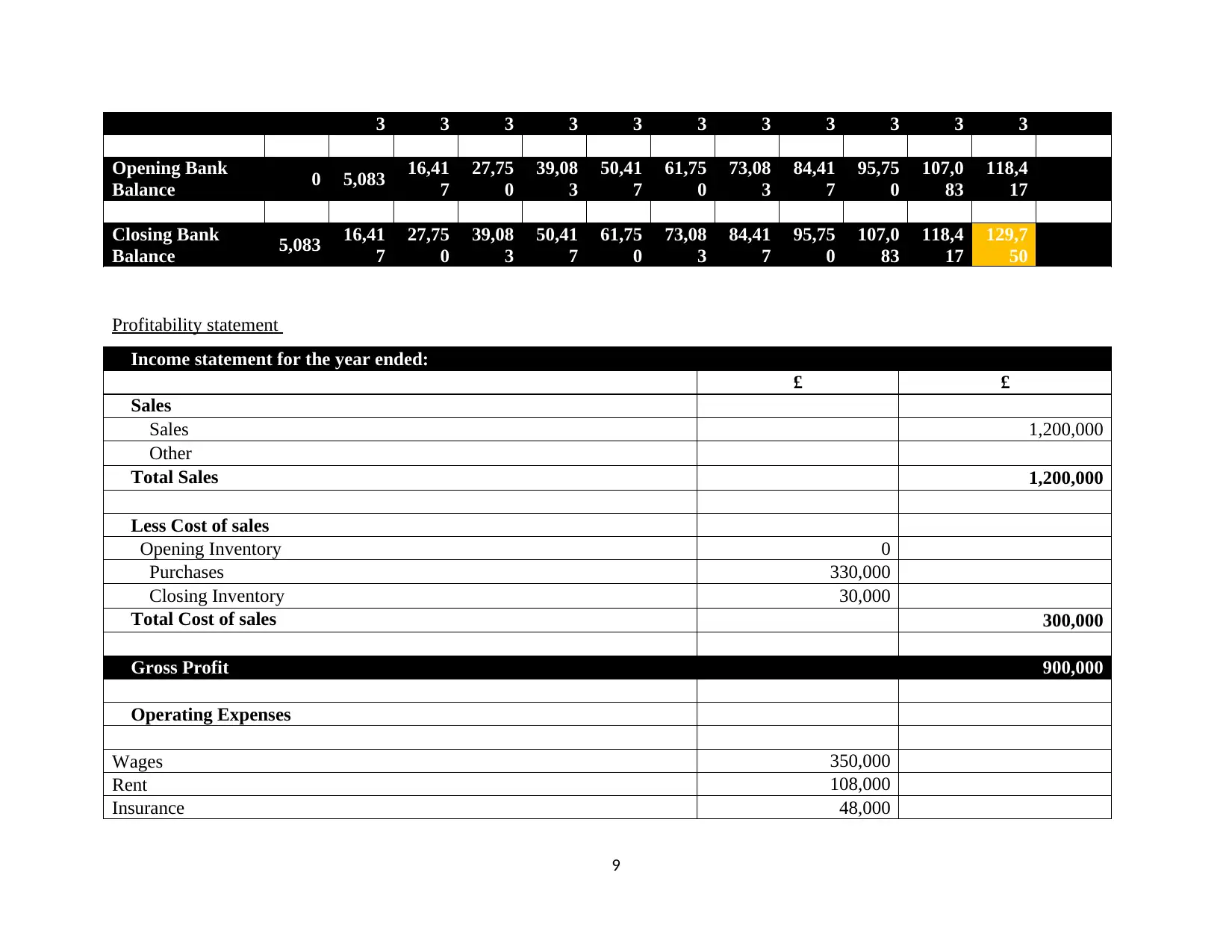
3 3 3 3 3 3 3 3 3 3 3
Opening Bank
Balance 0 5,083 16,41
7
27,75
0
39,08
3
50,41
7
61,75
0
73,08
3
84,41
7
95,75
0
107,0
83
118,4
17
Closing Bank
Balance 5,083 16,41
7
27,75
0
39,08
3
50,41
7
61,75
0
73,08
3
84,41
7
95,75
0
107,0
83
118,4
17
129,7
50
Profitability statement
Income statement for the year ended:
£ £
Sales
Sales 1,200,000
Other
Total Sales 1,200,000
Less Cost of sales
Opening Inventory 0
Purchases 330,000
Closing Inventory 30,000
Total Cost of sales 300,000
Gross Profit 900,000
Operating Expenses
Wages 350,000
Rent 108,000
Insurance 48,000
9
Opening Bank
Balance 0 5,083 16,41
7
27,75
0
39,08
3
50,41
7
61,75
0
73,08
3
84,41
7
95,75
0
107,0
83
118,4
17
Closing Bank
Balance 5,083 16,41
7
27,75
0
39,08
3
50,41
7
61,75
0
73,08
3
84,41
7
95,75
0
107,0
83
118,4
17
129,7
50
Profitability statement
Income statement for the year ended:
£ £
Sales
Sales 1,200,000
Other
Total Sales 1,200,000
Less Cost of sales
Opening Inventory 0
Purchases 330,000
Closing Inventory 30,000
Total Cost of sales 300,000
Gross Profit 900,000
Operating Expenses
Wages 350,000
Rent 108,000
Insurance 48,000
9
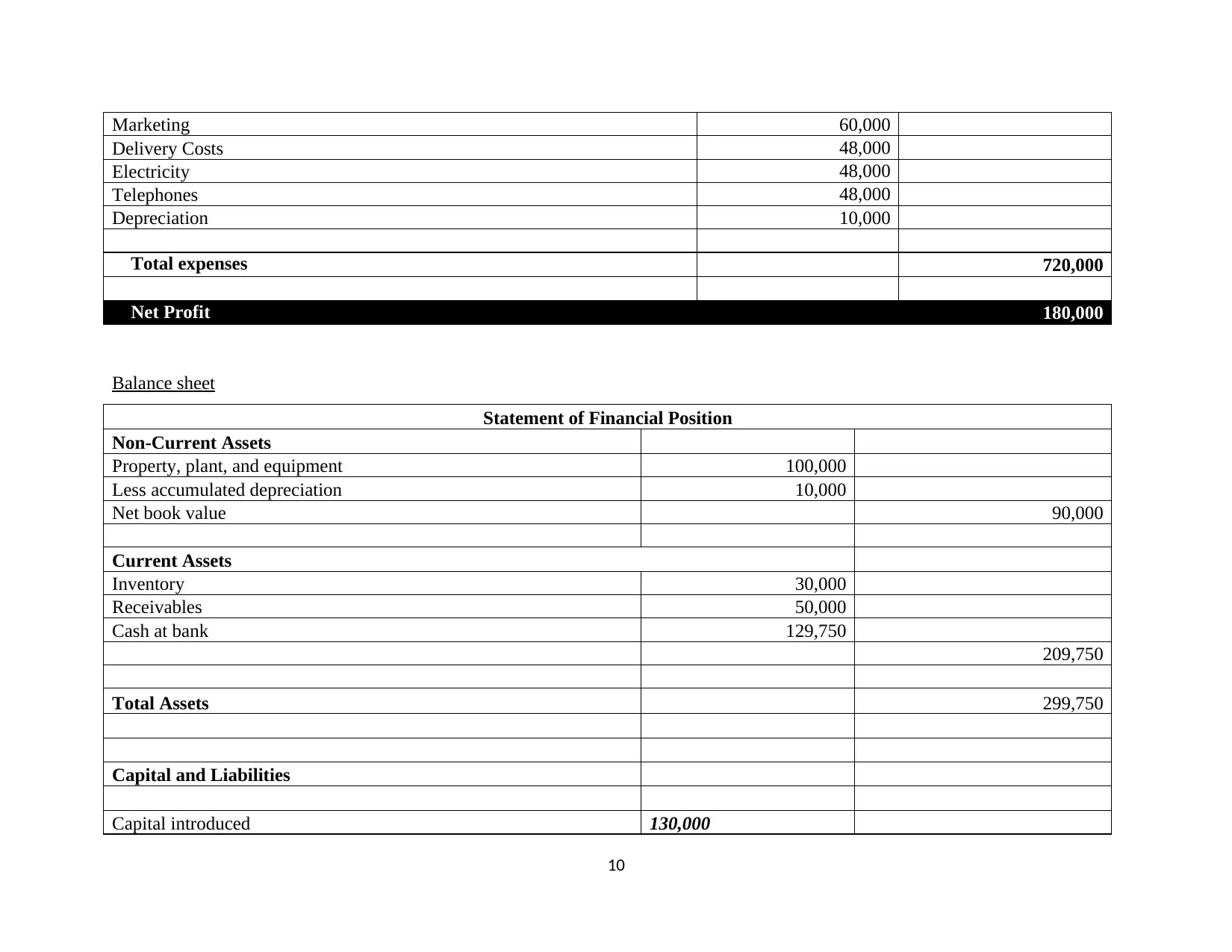
Marketing 60,000
Delivery Costs 48,000
Electricity 48,000
Telephones 48,000
Depreciation 10,000
Total expenses 720,000
Net Profit 180,000
Balance sheet
Statement of Financial Position
Non-Current Assets
Property, plant, and equipment 100,000
Less accumulated depreciation 10,000
Net book value 90,000
Current Assets
Inventory 30,000
Receivables 50,000
Cash at bank 129,750
209,750
Total Assets 299,750
Capital and Liabilities
Capital introduced 130,000
10
Delivery Costs 48,000
Electricity 48,000
Telephones 48,000
Depreciation 10,000
Total expenses 720,000
Net Profit 180,000
Balance sheet
Statement of Financial Position
Non-Current Assets
Property, plant, and equipment 100,000
Less accumulated depreciation 10,000
Net book value 90,000
Current Assets
Inventory 30,000
Receivables 50,000
Cash at bank 129,750
209,750
Total Assets 299,750
Capital and Liabilities
Capital introduced 130,000
10
Paraphrase This Document
Need a fresh take? Get an instant paraphrase of this document with our AI Paraphraser
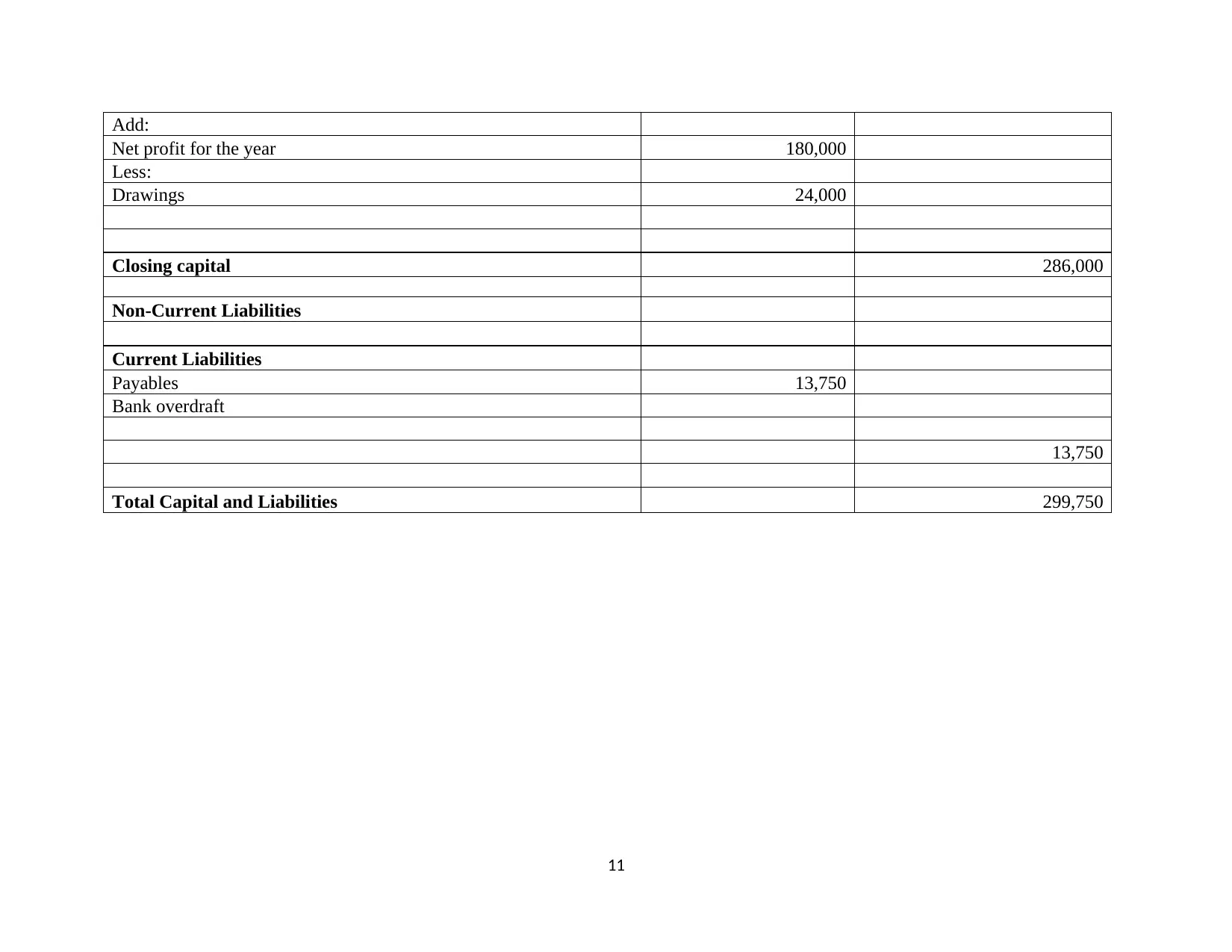
Add:
Net profit for the year 180,000
Less:
Drawings 24,000
Closing capital 286,000
Non-Current Liabilities
Current Liabilities
Payables 13,750
Bank overdraft
13,750
Total Capital and Liabilities 299,750
11
Net profit for the year 180,000
Less:
Drawings 24,000
Closing capital 286,000
Non-Current Liabilities
Current Liabilities
Payables 13,750
Bank overdraft
13,750
Total Capital and Liabilities 299,750
11
1 out of 14
Related Documents
Your All-in-One AI-Powered Toolkit for Academic Success.
+13062052269
info@desklib.com
Available 24*7 on WhatsApp / Email
![[object Object]](/_next/static/media/star-bottom.7253800d.svg)
Unlock your academic potential
© 2024 | Zucol Services PVT LTD | All rights reserved.




![[SOLVED] Projected Statements and Financial Ratios](/_next/image/?url=https%3A%2F%2Fdesklib.com%2Fmedia%2Fimages%2Fwu%2Fe9fde74d86d549c2a5887755687e52c6.jpg&w=256&q=75)
